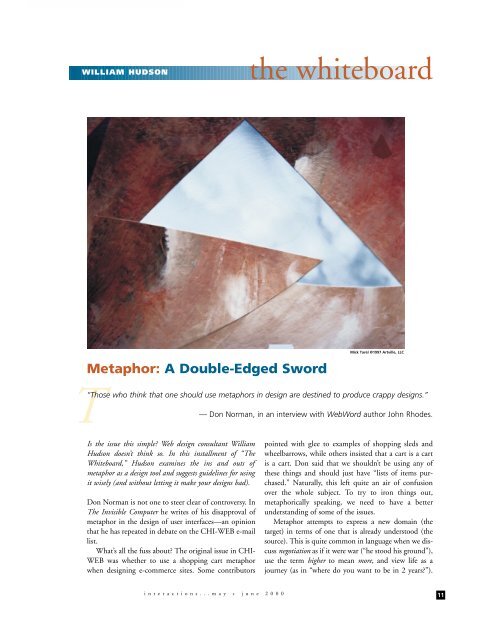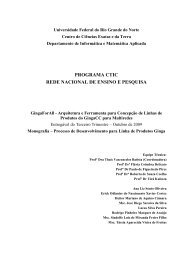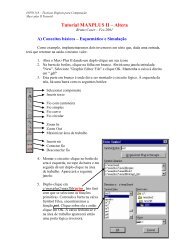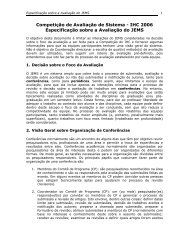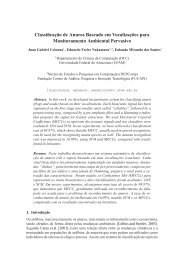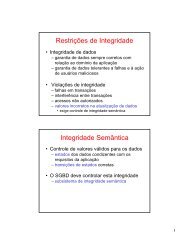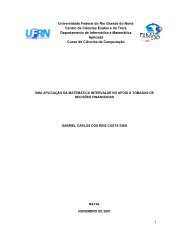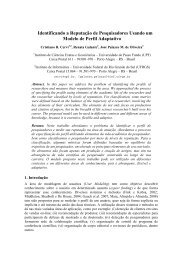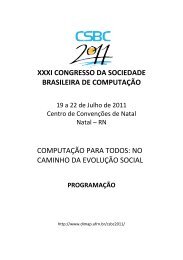Metaphor: A Double-Edged Sword - DIMAp
Metaphor: A Double-Edged Sword - DIMAp
Metaphor: A Double-Edged Sword - DIMAp
Create successful ePaper yourself
Turn your PDF publications into a flip-book with our unique Google optimized e-Paper software.
WILLIAM HUDSON the<br />
<strong>Metaphor</strong>: A <strong>Double</strong>-<strong>Edged</strong> <strong>Sword</strong><br />
i n t e r a c t i o n s . . . m a y + j u n e 2 0 0 0<br />
whiteboard<br />
Mick Tarel ©1997 Artville, LLC<br />
T“Those who think that one should use metaphors in design are destined to produce crappy designs.”<br />
Is the issue this simple? Web design consultant William<br />
Hudson doesn’t think so. In this installment of “The<br />
Whiteboard,” Hudson examines the ins and outs of<br />
metaphor as a design tool and suggests guidelines for using<br />
it wisely (and without letting it make your designs bad).<br />
Don Norman is not one to steer clear of controversy. In<br />
The Invisible Computer he writes of his disapproval of<br />
metaphor in the design of user interfaces—an opinion<br />
that he has repeated in debate on the CHI-WEB e-mail<br />
list.<br />
What’s all the fuss about? The original issue in CHI-<br />
WEB was whether to use a shopping cart metaphor<br />
when designing e-commerce sites. Some contributors<br />
— Don Norman, in an interview with WebWord author John Rhodes.<br />
pointed with glee to examples of shopping sleds and<br />
wheelbarrows, while others insisted that a cart is a cart<br />
is a cart. Don said that we shouldn’t be using any of<br />
these things and should just have “lists of items purchased.”<br />
Naturally, this left quite an air of confusion<br />
over the whole subject. To try to iron things out,<br />
metaphorically speaking, we need to have a better<br />
understanding of some of the issues.<br />
<strong>Metaphor</strong> attempts to express a new domain (the<br />
target) in terms of one that is already understood (the<br />
source). This is quite common in language when we discuss<br />
negotiation as if it were war (“he stood his ground”),<br />
use the term higher to mean more, and view life as a<br />
journey (as in “where do you want to be in 2 years?”).<br />
11
12<br />
WHITEBOARD<br />
COLUMN EDITOR<br />
Elizabeth Buie<br />
Senior Principal Engineer<br />
Computer Sciences<br />
Corporation<br />
15245 Shady Grove Road<br />
Rockville, MD 20850<br />
+1-301-921-3326<br />
fax: +1-301-921-2069<br />
ebuie@csc.com<br />
Some psychologists even argue that thought<br />
and language are fundamentally metaphoric.<br />
Unfortunately this model of metaphor is complex,<br />
requires a good understanding of both<br />
the source and target domains, and is specific<br />
within culture and language. A more suitable<br />
approach to user interface design is the structure<br />
mapping theory of analogy. The work of<br />
Dedre Gentner and her colleagues, this theory<br />
still relates target and source domains, but by<br />
considering the relationships between the conceptual<br />
objects (concepts) within each.<br />
The Controversy<br />
What are the objections to using metaphor in<br />
user interface design? The most commonly<br />
quoted are that metaphor is helpful only to<br />
inexperienced users and that it is overly<br />
restrictive. The “desktop” metaphor, which is<br />
Figure 1. Conceptual model of a mid-1970s office.<br />
i n t e r a c t i o n s . . . m a y + j u n e 2 0 0 0<br />
the basis of most graphical environments<br />
found today, is often cited as an example of<br />
the failure of metaphorical design. However, I<br />
think it deserves a closer look. Figure 1 shows<br />
a conceptual model of the source domain: an<br />
office of the mid 1970s. The rectangles represent<br />
concepts, and the connecting lines represent<br />
relationships. I drew the model in the<br />
style of a unified modeling language (UML)class<br />
model. In the model, concepts and relationships<br />
are read from the labeled end of<br />
each line. So, for example, in-tray receives document<br />
and filing cabinet stores folder. This<br />
model (with some minor changes, such as<br />
printer instead of copier) was the basis of the<br />
desktop metaphor used on the Xerox Star, the<br />
inspiration for the Apple Macintosh,<br />
Microsoft Windows, and other graphical<br />
environments. The trays, folders, documents,<br />
and other concepts were<br />
represented with clear<br />
icons and descriptive<br />
text, allowing inexperienced<br />
computer users to<br />
rapidly learn the use of a<br />
complex and innovative<br />
computer system.<br />
Notice, by the way,<br />
that Figure 1 includes a<br />
relationship that isn’t of<br />
the same type as the<br />
others: desktop covered by<br />
blotter. Although this relationship<br />
was true of many<br />
desktops at the time, most<br />
of the other relationships<br />
are concerned with<br />
actions. The relationship<br />
between desktop and<br />
blotter is superficial and<br />
not part of the system of<br />
relationships that interest<br />
us. This is called a nonsystematic<br />
relationship.<br />
But why is the desktop<br />
metaphor unhelpful? I<br />
think the desktop<br />
metaphor on our computer<br />
screens has drifted<br />
too far from the original
office domain. Microsoft Windows, for<br />
example, hides the in-tray and out-tray in an<br />
e-mail application, variously called Mail,<br />
Inbox, Outlook, or Outlook Express<br />
depending on the age and configuration of<br />
the system. The desktop is confusingly covered<br />
by wallpaper, and printing documents by<br />
dragging them to a printer does not work reliably.<br />
The Macintosh does not fare much<br />
better: it has the odd feature of allowing users<br />
to drag the floppy disk to the wastebasket<br />
(“Trash”) to eject the floppy. From the office<br />
domain it’s obvious that the effect of that<br />
action (if any) should be the same as discarding<br />
a document or folder. So in most<br />
cases, the apparent problem with the desktop<br />
metaphor is that it does not correspond to the<br />
original office domain.<br />
Now we turn to the suggestion that<br />
metaphors confine their designers and users.<br />
This supposes that by establishing a wellunderstood<br />
system of relationships we are<br />
limited to just those relationships. Although it<br />
is likely that inexperienced users will understand<br />
the metaphor literally, this same understanding<br />
will give them the confidence to<br />
explore and experiment. As long as we do not<br />
introduce anomalous relationships such as<br />
wastebasket ejects floppy, there will still be considerable<br />
freedom to innovate. For example,<br />
within the desktop metaphor, we could make<br />
use of a stapler to group and compress documents<br />
(compared with the now common<br />
zipper concept that is not part of the office<br />
domain; see Error! Reference source not<br />
found.). We can also use bridging concepts to<br />
move from one metaphor to another. A screwdriver<br />
(Figure 3) could be used as a bridge<br />
from the desktop metaphor to the physical<br />
hardware. More advanced users might be able<br />
to drag the screwdriver to the filing cabinet to<br />
perform maintenance operations such as<br />
modifying partitions or defragmenting<br />
storage. All these metaphorical design features<br />
could be used in addition to more direct (but<br />
less predictable) mechanisms such as popup<br />
menus and shortcut keys.<br />
Some Problems<br />
Having defended the general concept of<br />
metaphor, let’s be honest about its limitations.<br />
The first problem is that designers<br />
sometimes use metaphor too literally. For<br />
example, in a real office, mailing a document<br />
to a customer means that you no longer have<br />
a copy of it, unless you have explicitly made a<br />
copy beforehand. Enforcing this in a virtual<br />
office would be incredibly frustrating to<br />
users. Mindless consistency is not an attractive<br />
design strategy.<br />
A larger difficulty is that there aren’t many<br />
useful metaphors for completely new<br />
problem domains; the most successful<br />
metaphors “virtualize” an existing problem<br />
domain. This means adopting not only the<br />
concepts and relationships of the domain,<br />
but also the activities, as shown for a “virtual<br />
store” in Figure 4. Other candidates for virtualization<br />
are libraries, clubs, medical services,<br />
and automotive sales and service—in<br />
short, most things that have well-defined<br />
domains.<br />
OR<br />
Figure 2. Which has a more predictable effect on documents?<br />
The Name’s the<br />
Thing<br />
The debate over terms<br />
shopping sled versus<br />
shopping cart may<br />
seem trivial at first<br />
sight. It is easy to<br />
forget that to inexperienced<br />
Web shoppers,<br />
a shopping cart may<br />
be a familiar comfort.<br />
Arriving at an e-commerce<br />
site that does<br />
Figure 3. Bridging concept from desktop to<br />
hardware.<br />
i n t e r a c t i o n s . . . m a y + j u n e 2 0 0 0 13
14<br />
Figure 4. Activity (state) diagram for a virtual store.<br />
not use the shopping cart metaphor may be a<br />
learning experience, rather than a shopping<br />
one. It could also be a wasted learning experience<br />
if most other Web sites use different concepts<br />
and activities. The novelty will be<br />
beneficial only if it offers a real improvement<br />
over familiar solutions and is adopted by the<br />
Internet community as a whole.<br />
An Iceberg Model of <strong>Metaphor</strong><br />
Many concepts are domain specific. For<br />
example, a cash register is almost always associated<br />
with shopping and the activity of<br />
paying. Other concepts, such as money, are<br />
much more general. The image of money in<br />
an e-commerce site could be associated with<br />
paying, but it might also mean pricing, discounts,<br />
or currency. The difference is that<br />
using a domain-specific concept such as a cash<br />
visible<br />
invisible<br />
Figure 5. Check in has a reservation hidden below the surface.<br />
i n t e r a c t i o n s . . . m a y + j u n e 2 0 0 0<br />
register invokes the system of hidden relationships<br />
to which it belongs. The cash register<br />
may be the only visible evidence of the<br />
metaphor, but the rest of the shopping<br />
domain lurks beneath the surface.<br />
This “iceberg” model of metaphor can present<br />
problems as well as providing solutions. A<br />
number of Web sites have begun using the<br />
term check in. Some use it as an activity<br />
required of visitors to the Web site (i.e., registering<br />
or joining), and others ask existing<br />
members to check in. Which is correct? The<br />
term is used almost exclusively in the travel<br />
industry to mean registration for a prearranged<br />
journey or stay and so is associated<br />
with a reservation, as shown in Figure 5. The<br />
question of whether the customer is a visitor<br />
or a member does not really arise, except that<br />
a member might be tenuously considered to<br />
have a reservation. It would be best not to use<br />
the term at all outside its travel context.<br />
<strong>Metaphor</strong>ic Guidelines<br />
My own view is that metaphor is an important<br />
tool for user interface design but must be used<br />
with care. The following guidelines cover the<br />
most important issues.<br />
✦ <strong>Metaphor</strong>s operate on systems of relationships,<br />
not on individual concepts.<br />
Make sure that the system of relationships<br />
is reflected in your user interface,<br />
and do not use concepts out of context.<br />
✦ <strong>Metaphor</strong>s do not have to be complete,<br />
but interfaces need to provide<br />
adequate clues to users. Omitting less
important concepts or changing them<br />
slightly may not significantly affect<br />
usability, but only testing will tell.<br />
✦ <strong>Metaphor</strong>s should not rely on mere<br />
appearance. A concept should not just<br />
have the appearance of a shopping<br />
basket; it should behave like one too. It<br />
needs to have the same or similar relationships<br />
in the target domain as it did<br />
in the source.<br />
✦ Avoid nonsystematic relationships<br />
(such as desktop covered by blotter in<br />
Figure 1). Most of the important relationships<br />
will include how concepts<br />
interact with each other, particularly<br />
from a user’s perspective.<br />
✦ Don’t let abstract relationships interfere<br />
with the metaphor. For instance,<br />
it may be true that a desk and a filing<br />
cabinet are both instances of office furniture.<br />
However, it’s their purpose that<br />
is of interest.<br />
✦ Choose metaphors that provide concrete<br />
images. The shopping domain is<br />
useful because it contains a number of<br />
domain-specific concepts that can<br />
easily be represented visually: shopping<br />
cart (or basket, or trolley), cash register,<br />
price tags, discount signs. A catalog<br />
metaphor, by comparison, is relatively<br />
devoid of distinct concrete images (an<br />
order form is not as immediately recognizable<br />
as a cart or basket).<br />
✦ Try to get as close to the original<br />
domain as possible (unless an alternative<br />
has obvious advantages). Mailorder<br />
shopping and vending machines<br />
are already one step removed from the<br />
source shopping domain. Also, some<br />
aspects of the vending machine domain<br />
are not entirely beneficial to e-com-<br />
i n t e r a c t i o n s . . . m a y + j u n e 2 0 0 0<br />
merce: Vending machines usually sell<br />
low-value items, most require payment<br />
in advance, and not all are reliable.<br />
✦ Beware culture-specific metaphors and<br />
concepts. Cart (US) versus trolley<br />
(UK) is a minor issue since the image is<br />
the same. However, kiss and ride<br />
(dropping off a loved one at a public<br />
transport facility) does not enjoy widespread<br />
recognition.<br />
Further Reading<br />
Gentner, D. and Markman, A. B. Structure<br />
mapping in analogy and similarity. American<br />
Psychologist 52 (1997), pp. 45-56.<br />
Ortony, A., ed. <strong>Metaphor</strong> and Thought.<br />
Cambridge University Press, Cambridge,<br />
United Kingdom, 1993.<br />
Rhodes, J. Thinking beyond usability: An<br />
interview with Don Norman, http://<br />
webword.com/interviews/norman.html,<br />
1999.<br />
The CHI-WEB mailing list is archived at<br />
http://www.acm.org/archives/chi-web.html.<br />
To subscribe to CHI-WEB, complete the<br />
form at http://www.acm.org/sigchi/listserv/<br />
request.html.<br />
William Hudson is a freelance software designer<br />
based near Oxford in the United Kingdom. Since<br />
he began writing interactive software in the<br />
early 1970s, Hudson has gained experience in<br />
computing topics ranging from firmware to<br />
desktop applications. For the past 10 years he<br />
has focused on user interface design, object-oriented<br />
design, and human-computer interaction.<br />
When Hudson’s head is not stuck inside a conceptual<br />
model, it is firmly wedged in a mountain<br />
bike helmet or diver’s mask.<br />
E-mail: WHudson@syntagm.co.uk.<br />
PERMISSION TO MAKE DIGITAL OR<br />
HARD COPIES OF ALL OR PART OF THIS<br />
WORK FOR PERSONAL OR CLASSROOM<br />
USE IS GRANTED WITHOUT FEE<br />
PROVIDED THAT COPIES ARE NOT<br />
MADE OR DISTRIBUTED FOR PROFIT OR<br />
COMMERCIAL ADVANTAGE AND THAT<br />
COPIES BEAR THIS NOTICE AND THE<br />
FULL CITATION ON THE FIRST PAGE.<br />
TO COPY OTHERWISE, TO REPUBLISH,<br />
TO POST ON SERVERS OR TO REDIS-<br />
TRIBUTE TO LISTS, REQUIRES PRIOR<br />
SPECIFIC PERMISSION AND/OR A FEE.<br />
© ACM 1072-5220/00/0500 $5.00<br />
15


